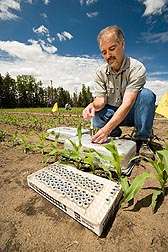Farms, Fertilizers and Greenhouse Gas Emissions

(PhysOrg.com) -- Agricultural Research Service (ARS) scientists are front and center in finding out how farming affects emissions of the green house nitrous oxide (N2O).
Experts already know that N2O emissions rise as applications of nitrogen-based fertilizers increase. Microbiologist Tim Parkin, who works at the ARS National Laboratory for Agriculture and the Environment in Ames, Iowa, is part of a team that is studying how different soils and different fertilizers affect N2O emissions.
The researchers assessed the variation in the emissions of N2O, carbon dioxide and methane from two different soil types—a sandy loam mix and a clay soil. The two fertilizers used in the study were urea-ammonium nitrate (UAN) and a liquid swine manure slurry.
They found that overall N2O emission levels were highest from soils amended with swine manure slurry. High levels of N2O emissions were measured from sandy loam soils amended either with UAN or slurry. But on the clay soils, only those amended with slurry—and not with UAN—had elevated N2O emissions.
Soil scientist Rod Venterea, who works at the ARS Soil and Water Management Research Unit in St. Paul, Minn., is also studying N2O emission dynamics. He found that the amount of N2O emitted from fields fertilized with anhydrous ammonia was on average twice as high as emissions from fields fertilized with urea. The higher emissions from anhydrous ammonia were likely derived from the conversion of ammonia to nitrate.
His findings also suggest that farmers using reduced tillage can minimize N2O emissions by placing fertilizers below the upper 2 to 3 inches of soil. This is because in a reduced tillage system, the microorganisms that support N2O emissions are concentrated in the topmost soil layer.
Results from Parkin's research were published in the Journal of Environmental Quality in 2008. Venterea's work was published in Global Change Biology in 2007 and the Journal of Environmental Quality in 2005 and 2008.
Read more about this research in the November/December 2009 issue of Agricultural Research magazine.
Provided by USDA Agricultural Research Service

















